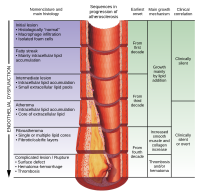
Photo from wikipedia
Abstract Aims Brown fat activation accelerates the uptake of cholesterol-enriched remnants by the liver and thereby lowers plasma cholesterol, consequently protecting against atherosclerosis development. Hepatic cholesterol is then converted into… Click to show full abstract
Abstract Aims Brown fat activation accelerates the uptake of cholesterol-enriched remnants by the liver and thereby lowers plasma cholesterol, consequently protecting against atherosclerosis development. Hepatic cholesterol is then converted into bile acids (BAs) that are secreted into the intestine and largely maintained within the enterohepatic circulation. We now aimed to evaluate the effects of prolonged brown fat activation combined with inhibition of intestinal BA reabsorption on plasma cholesterol metabolism and atherosclerosis development. Methods and results APOE*3-Leiden.CETP mice with humanized lipoprotein metabolism were treated for 9 weeks with the selective β3-adrenergic receptor (AR) agonist CL316,243 to substantially activate brown fat. Prolonged β3-AR agonism reduced faecal BA excretion (−31%), while markedly increasing plasma levels of total BAs (+258%), cholic acid-derived BAs (+295%), and chenodeoxycholic acid-derived BAs (+217%), and decreasing the expression of hepatic genes involved in BA production. In subsequent experiments, mice were additionally treated with the BA sequestrant Colesevelam to inhibit BA reabsorption. Concomitant intestinal BA sequestration increased faecal BA excretion, normalized plasma BA levels, and reduced hepatic cholesterol. Moreover, concomitant BA sequestration further reduced plasma total cholesterol (−49%) and non-high-density lipoprotein cholesterol (−56%), tended to further attenuate atherosclerotic lesion area (−54%). Concomitant BA sequestration further increased the proportion of lesion-free valves (+34%) and decreased the relative macrophage area within the lesion (−26%), thereby further increasing the plaque stability index (+44%). Conclusion BA sequestration prevents the marked accumulation of plasma BAs as induced by prolonged brown fat activation, thereby further improving cholesterol metabolism and reducing atherosclerosis development. These data suggest that combining brown fat activation with BA sequestration is a promising new therapeutic strategy to reduce hyperlipidaemia and cardiovascular diseases.
Journal Title: Cardiovascular Research
Year Published: 2019
Link to full text (if available)
Share on Social Media: Sign Up to like & get
recommendations!